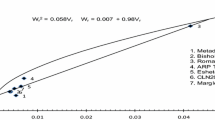Summary
Genetical and biochemical studies on the wild, green fruited tomato speciesLycopersicum minutum showed that the level of ascorbic acid found in its fruits is much higher than that inL. esculentum. The characteristic of high asorbic acid level is an inherited one and can be transferred into cultivated tomato varieties. Some lines derived from the interspecific crossL. esculentum xL. minutum show as high ascorbic acid level as 43 mg % while standard tomato strains have 17 mg %. The mode of inheritance of high ascorbic acid level is not yet clearly explained and further investigations are being carried out.
Zusammenfassung
Bei unseren Forschungsarbeiten mit einer Wildtomate mit grünen Früchten,Lycopersicum minutum, wurde festgestellt, daß diese hinsichtlich des Ascorbinsäuregehaltes in den Früchten, die KulturartL. esculentum stark übersteigt. Dieses Merkmal des hohen Ascorbinsäure-Gehaltes ist erblich und kann auf die Kulturarten übertragen werden. Einige Linien, welche aus der Kreuzung zwischen den ArtenL. esculentum undL. minutum stammen, weisen 43 mg % Ascorbinsäure auf, während die normalen Arten nur 17 mg % haben. Die Art und Weise der Erblichkeit des Merkmales des höheren Ascorbinsäuregehaltes ist noch nicht genau bestimmt und erfordert weitere Forschungen.
Résumé
La tomate sauvage aux fruits verts de l'espèceLycopersicon minutum, est nettement supérieure aux tomates cultivées par son taux d'acide ascorbique dans les fruits. Ce caractere, du taux élevé d'acide ascorbique, est héréditaire et peut-être transmis aux espèces cultivées. On trouve dans certaines lignées provenant du croisement entre les espècesL. esculentum xL. minutum 43 mg % d'acide ascorbique, tandisque les espèces standardisées n'en ont que 17 mg %. Le mécanisme par le quel le taux élevé d'acide ascorbique s'hérite, n'a pas encore été pleinement déterminé et des études ultérieures sur ce sujet s'imposent.
Similar content being viewed by others
Literature
Chmielewski, T., 1962. Cytogenetical and taxonomical studies on a new tomato form.Genet. Polonica 3:253–264.
Manunta, C., 1954. Ulteriori indagini sulla selezione dei pomodori ad alto contenuto in provitamina A e vitamina C.Genet. agr. 4:116–145.
Manunta, C., 1958a. La ricchezza in vitamine nei pomodori.Genet. agr. 10:1–16.
Reynard, G. B., &M. S. Kanapaux., 1942. Ascorbic acid (vitamin C) content of some tomato varieties and species.Proc. Amer. Soc. hort. Sci. 41:298–300.
Tillmans, J., 1927. Über die Bestimmung der elektrischen Reduktions-Oxydations Potentiale und ihre Anwendung in der Lebensmittelchemie.Z. Unters. Lebensm. 54:33–43.
Ward, G. M., 1963. Ascorbic acid in tomatoes. I. Distribution and method of assay.Canad. J. Plant Sci 43:206–213.
Yeager, A. F. &H. J. Purinton., 1946.Lycopersicon peruvianum as a parent in the development of high ascorbic acid tomato varieties.Proc. Amer. Soc. hort. Sci. 48:403–405.
Author information
Authors and Affiliations
Additional information
Paper read in Lund, Sweden (EUCARPIA-CIQ Congress, 14th to 17th July 1965) on 17/7/1965.
Rights and permissions
About this article
Cite this article
Berger, S., Chmielewski, T. & Gronowska-Senger, A. Studies on the inheritance of high ascorbic acid level in tomatoes. Plant Food Hum Nutr 13, 214–218 (1966). https://doi.org/10.1007/BF01103406
Issue Date:
DOI: https://doi.org/10.1007/BF01103406




